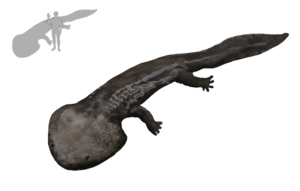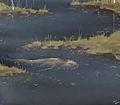Koolasuchus facts for kids
Quick facts for kids Koolasuchus |
|
|---|---|
 |
|
| Restoration and size comparison to a human | |
| Scientific classification |
|
| Kingdom: | Animalia |
| Phylum: | Chordata |
| Order: | †Temnospondyli |
| Suborder: | †Stereospondyli |
| Family: | †Chigutisauridae |
| Genus: | †Koolasuchus Warren et al., 1997 |
| Type species | |
| †Koolasuchus cleelandi Warren et al., 1997
|
|
Koolasuchus was a giant amphibian that lived a very long time ago. It belonged to a group called temnospondyls. Scientists have found its fossils in Victoria, Australia. These fossils are about 120 million years old! This makes Koolasuchus the youngest known temnospondyl ever found. It's known from parts of its skull and other bones like ribs. The main type of Koolasuchus is called Koolasuchus cleelandi, named in 1997.
Contents
What Did Koolasuchus Look Like?

Koolasuchus was an amphibian that lived in water. Scientists think it was about 4 to 5 meters (13 to 16 feet) long. That's about the length of a small car! It might have weighed up to 500 kilograms (1,100 pounds). Even though we don't have a complete skeleton, its skull was probably around 65 centimeters (25 inches) long. Like other animals in its family, it had a very wide, rounded head. It also had special bony bumps called tabular horns at the back of its skull.
How Was Koolasuchus Discovered?
Koolasuchus got its name in 1997. Its fossils were found in a rock layer called the Strzelecki Group in Victoria. Scientists found four pieces of its lower jaw. They also found other bones like ribs, parts of its backbone, and leg bones.
The first jawbone was found in 1978. It was discovered at a fossil site called the Punch Bowl, near San Remo. More bones were found later in 1989 at a nearby place called Rowell's Beach. Scientists also have a partial skull, but it's still being prepared.
The name Koolasuchus honors a scientist named Lesley Kool. It's also a fun play on words, sounding like "cool." This refers to the cold climate where it lived. The full species name, K. cleelandi, is named after another scientist, Mike Cleeland.
Where Did Koolasuchus Live?
Koolasuchus lived in river valleys in southern Australia. This was during the Early Cretaceous period. At that time, this part of Australia was very far south. It was actually inside the Antarctic Circle! This meant the temperatures were quite cool, especially for the time of the Mesozoic Era.
Scientists believe Koolasuchus lived in fast-moving rivers. This is because its bones were found in coarse, rough rocks. As a big animal that hunted in water, it lived a bit like modern-day crocodiles.
Interestingly, crocodiles were not common in southern Australia 120 million years ago. Scientists think this was because of the cold weather. But about 110 million years ago, the climate got warmer. Crocodiles then moved into the area. These new crocodiles likely competed with Koolasuchus for food and space. This competition probably led to Koolasuchus disappearing from the fossil record.
Images for kids
See also
 In Spanish: Koolasuchus para niños
In Spanish: Koolasuchus para niños



